“Compound interest is the eighth wonder of the world. He who understands it, earns it … he who doesn’t … pays it.”
Albert Einstein
For savvy investors and personal finance aficionados, the concept of compound interest is fundamental to growing wealth.
Reinvesting returns, exponential growth, rule of 72, etc… compound interest as a concept is simple to learn, but a difficult concept to master.
Brain teasers to test your grasp of compound interest
Here are some questions as an arbitrary test of compound interest mastery. Let’s see how many of them you can answer (without a calculator)
Question 1
How many times do you need to fold a 0.1mm piece of paper to reach the sun? 10 times, 50 times, 100 times, 5000 times, 10,000 times or 100,000 times? (The sun is roughly 150 million km away)
Question 2
If there is a lily pad in a pond which doubles in size every minute and will completely cover the pond in one hour, how long will it take to cover a quarter of the pond?
Question 3
What percentage of Warren Buffett’s wealth was created after he was 55? (His net worth is currently about USD 150 billion at age 94)
Question 4
Which is financially better after 50 years:
- Buying a property, or
- Renting the same property and investing the difference in total costs?
Assume typical property value appreciation of 5%, mortgage interest of 4%, rental yields of 4% of the property value and investment returns of 10%.
Question 5
What is the difference in net worth gains if someone invests 1,000 monthly at 10% p.a. returns for 30 years, versus someone who only starts a year later (only invests over 29 years)?
Are you ready for the answers to the brain teasers?
Question 1
About 50 times.
0.1mm X 2^50 = 113 million km (technically it’s 51 times, but close enough).
Sounds unbelievable? 50 times seems too little? Grab a large piece of paper, and see how many times you can fold it in half before you struggle. Every time you fold the paper, the thickness doubles.
- 1st fold: 0.2 mm
- 2nd fold: 0.4 mm
- 3rd fold: 0.8 mm
- ….
- 10th fold: 10.2 cm
- 20th fold: 104 m
- 30th fold: 107 km
- 40th fold: 109,951 km
- 50th fold: 113 million km
Question 2
58 minutes.
As the lily pad doubles in size every minute:
- 60 minutes = full pond coverage
- 59 minutes = half pond coverage
- 58 minutes = quarter pond coverage
Question 3
Over 99%.
Warren Buffet became a billionaire at 56 years old. With a net worth of USD 150 billion currently, he made almost all his wealth after 55. (Although reaching a billion dollars itself is an insane achievement). Want to see his net worth trajectory? Have a read of this article
Question 4
Renting a property. Even after the mortgage is paid off. The calculations are a bit tricky to show and require a rather large Excel table.
In a nutshell, with the savings from…
- Not needing to pay a downpayment and transaction fees, and
- Cheaper ongoing costs of renting vs mortgage, maintenance/upkeep and quit rent/taxes
… which these savings are reinvested into an index fund/ETF at 10% p.a. returns, the resulting net worth after 50 years is greater than the value of the property. This is even factoring in ongoing savings once the mortgage is completed.
Caveat: Although renting is almost always the financially better decision, owning a property can be a reasonable choice from a lifestyle and psychological perspective
Question 5
About 209k.
- Net worth for person 1 who invested 1,000 p.m. for 30 years = 2,171,328
- Net worth for person 1 who invested 1,000 p.m. for 29 years = 1,961,928
So keeping the habit of investing 12k per year for just one additional year over a 30-year period generates an extra 209k.
How many brain teasers did you guess correctly (or close enough)?
Compound interest is difficult to internalise and understand the long-term implications. Only after diligently investing for decades do most begin to understand the eighth wonder of the world through first-hand experience.
As a result, it’s quite ironic that it requires a leap of faith on the part of the individual to trust the process and the maths. Without that trust to take the leap of faith, it might be too late.
Practical takeaways from understanding compound interest
Answering brain teasers is nice and may give you a better appreciation of compound interest, but what are the practical learnings and takeaways?
Let me outline how it can help guide more of your actions and your psychology.
1. The more time you dedicate to investing, the more that compound interest can work its magic.
To most, this seems common sense and obvious, but I think what is significantly underappreciated is how significant starting to invest even one year earlier impacts the final number.
Remember question 5? You may have thought the difference would be a bit over RM13k – RM14k (an additional one year worth of RM 1k a month contributions plus some investment returns), which is the wrong way to think about it.
The right way to think about it is the effect of RM12k contributions plus compound interest on the final year of investing, which is pretty much a 17.5 times gain!
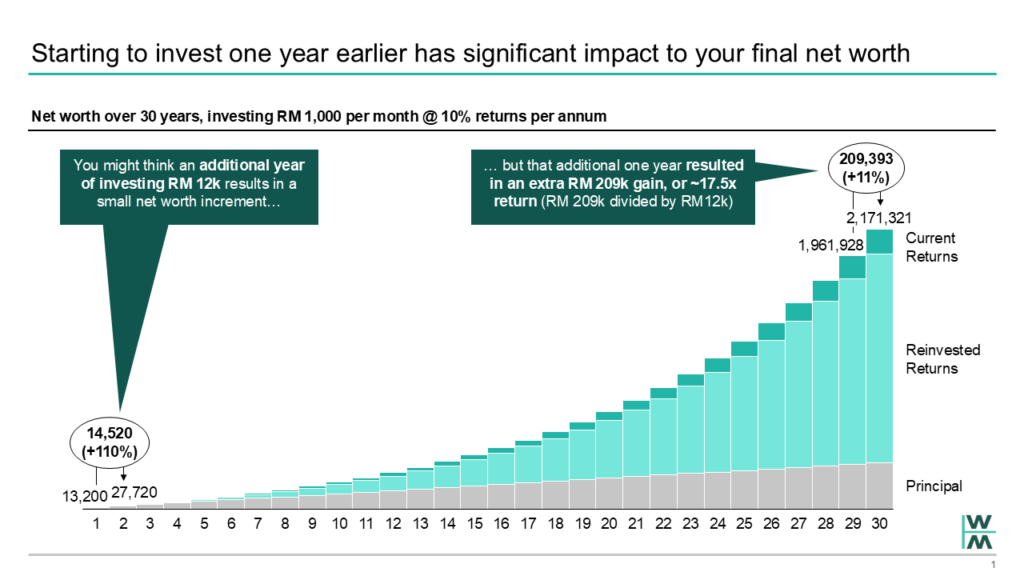
In addition to starting early, this also shows the impact of each additional year of investing at the point of time you want to retire. The seductive compound interest gains once you have accumulated a large net worth make it difficult to stop.
This is why many close to retirement find it difficult to pull the trigger. They think “just one more year”. It’s hard to say no when you see the potential for each additional year to add RM300k, RM500k or even RM1m+ to your net worth by just hanging on a bit longer. At that point, each additional year could significantly improve your lifestyle in retirement or significantly increase the longevity of the retirement savings.
For those at the early stages of your investment journey, you may be looking at the “small” 5% – 10% p.a. returns in comparison with your target 6 or 7-digit retirement savings number. It might look like Mount Everest and you wonder how you’re going to achieve your targets. If you’re diligent and have a good plan, don’t worry because…
2. You will likely only notice the effects of compound interest towards the later stages of your investing journey.
It does take a while for the effect of compound interest to snowball.
In the beginning, you feel like nothing is happening. 10% gains? On RM12k, that’s just RM1.2k.
You have to be patient and consistent.
When the impact of compound interest starts snowballing, it will appear like it “came out of nowhere”. Let’s revisit the same example. In the first 15 years, the gains seem… mediocre. But that’s only 19% of the end result. In the next 15 years, that’s where the compounding effect kicks in, with 81% of the final result:

This is why there is an old saying, “Your first million is difficult. Your second and subsequent million gets faster and easier”. It’s just maths. Getting to RM 1m by investing RM 1k a month takes a long time, about 22-23 years in the example. But getting the next RM1m is just doubling of RM 1m, requiring only 7-8 years.

The snowball effect, i.e. how fast your wealth grows the longer invest, makes achieving the next RM1m so fast that it becomes a yearly occurrence, given a long enough timeframe.
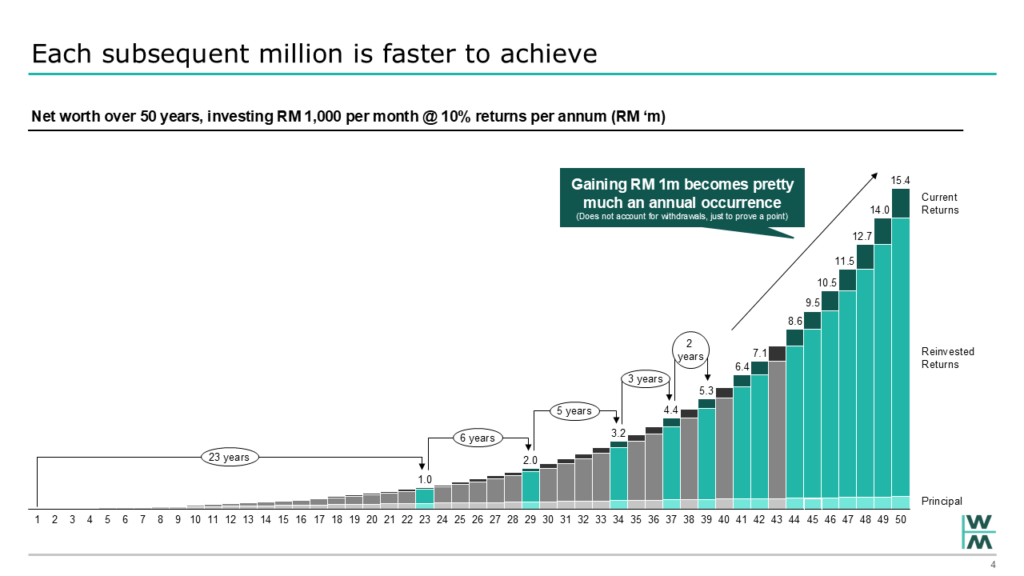
Now you know how Warren Buffett gained 99% of his net worth after the age of 55 (Question 3).
Caveat: In real life, the compounding is not a straight line and is subject to volatility, and this example is for illustrative purposes.
You might think “Oh great, I should then find better rates of return, so I can make the snowball effect even faster!”
I would caution that with…
3. Being patient and playing the long game. There is no shortcut to reach the later stages of compounding faster.
Only an extremely small handful of gifted people in this world can sustain multi-decade-long returns of over, say 12% per annum. If you can’t wait decades for the snowball to happen, you’re going to try to be greedy. Remember one of my 21 principles: Investment returns are always proportional to risk. And for investments which promise anything higher, it is not worth the risk. There is either an underappreciation by the (non-sophisticated) investor of the amount of risk or the investment is a scam.
If you find yourself getting impatient, or bored with the typical Boglehead approach of almost guaranteed 10% p.a. returns over decades, go find a hobby, put aside some play money or just stop looking at your portfolio every day and read points 1 & 2 again.
At the later stages when the compounding effect is significant, you may feel that your RM12k contribution hardly makes a dent after achieving such a large net worth. RM 12k might be 1% of your overall portfolio and you may be thinking “What’s the point of investing any additional money?”.
You could be right, and if you’re extremely frugal, let loose a bit. But for some of you, you might want to…
4. Keep the habit consistent, even in the last few years of working and saving.
This is because even small contributions (relative to your net worth) in the last few years of your wealth accumulation phase still have a lot of time to grow. That small contribution doesn’t have only a few years to compound but actually has another 20 or maybe even 30 years.
Where did this additional 20 to 30 years of compounding come from?
Don’t forget that your investments can still grow during the withdrawal/retirement phase of your life. So for the remainder of your retirement and as long as you’re still alive, there are potentially still a few decades for compound interest to work its magic.
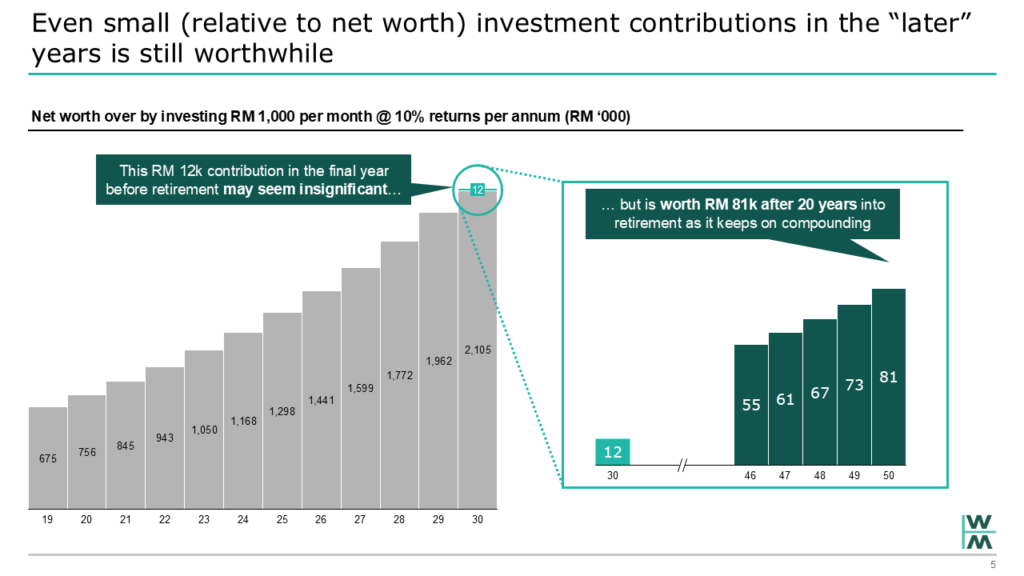
Remember: Discipline equals freedom.
5. Small differences in the compound interest rate grow to become significant over time.
You might think giving up 1% or 2% fewer returns in a RM 12k contribution is just a small amount at RM120, but the magic of compound interest works both ways. You pay significantly more in the long run.
Think about your actively managed ETFs or unit trusts, which charge up to 2% p.a. in management fees. Let’s see what happens in our typical investing scenario, but this time we’re charged a 1% fee:
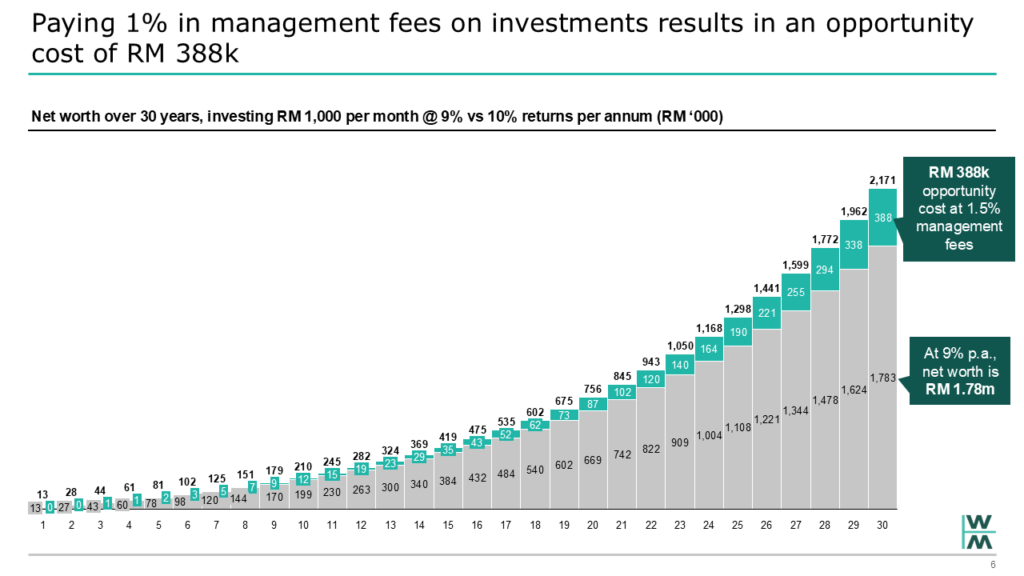
You’ve lost out on about 22% potential gains (RM 388k) as a result of paying 1% in fees. Instead of potentially having RM 2.17m net worth, you end up with RM 1.78.
How about 1.5% fees?
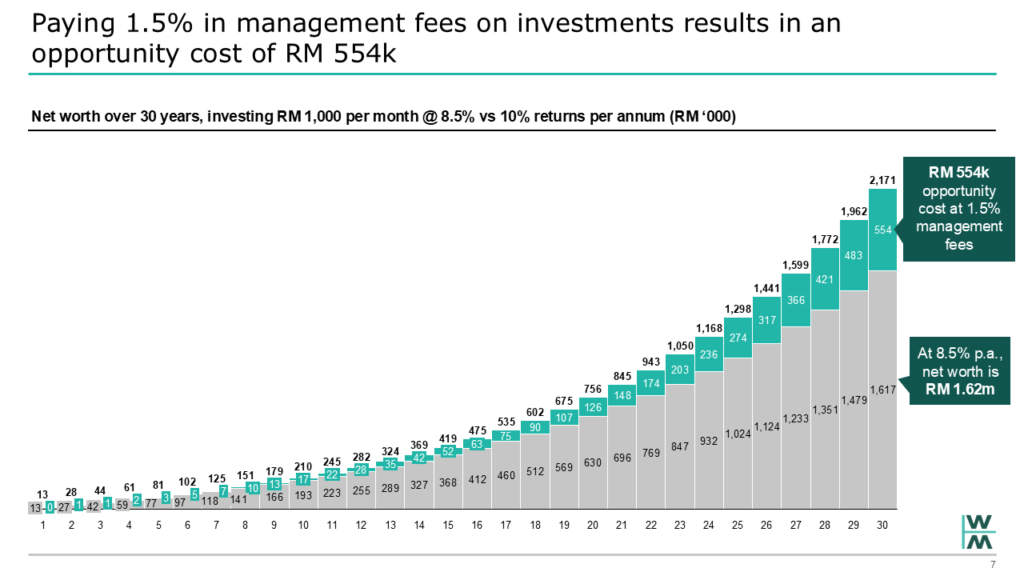
I don’t know about you, but I would hate to lose half a million ringgit. In this scenario, we’ve paid RM 554k in opportunity costs. A net worth of RM 1.62m instead of RM 2.17m.
To make up for this, we’d have to expect active fund managers to outperform the market by at least the same amount as the fees, so if the market average is 10%, we’d expect the fund manager to generate returns HIGHER than 11 – 12% over 30 years. They’re almost non-existent. And the 0.00001% of fund managers that can (Warren Buffett, Renaissance Technologies, Peter Lynch, etc.), are not available for you to invest directly.
Don’t get me started on 1.8% to 2% management fees. Or ridiculous 5% sales charges. Just stick to Boglehead index investing. Please.
This gets me to another interesting lesson about compound interest implications in Malaysia…
6. Private Retirement Schemes (PRS) in Malaysia are NOT worth the tax relief benefit in the long term.
PRS tax relief benefits do not compensate for their underperformance in the long term when compared to investing the same amount in an index fund.
For Malaysians, index investing in say S&P500 still delivers better long-term returns compared to PRS, even if tax relief amounts are reinvested.
Don’t believe me? Let’s take a hypothetical scenario using a hypothetical PRS vs a hypothetical index fund. Both generate 10% returns from an initial RM 3,000 investment (maximum amount for tax relief). Assume the tax relief is reinvested in the second year for more compounding gains. I’ll model two scenarios:
- 30% tax rate, the highest possible in Malaysia, and
- 25% tax rate, a more realistic tax rate
When does the Index fund outperform both tax relief scenarios?
After 17 and 20 years.
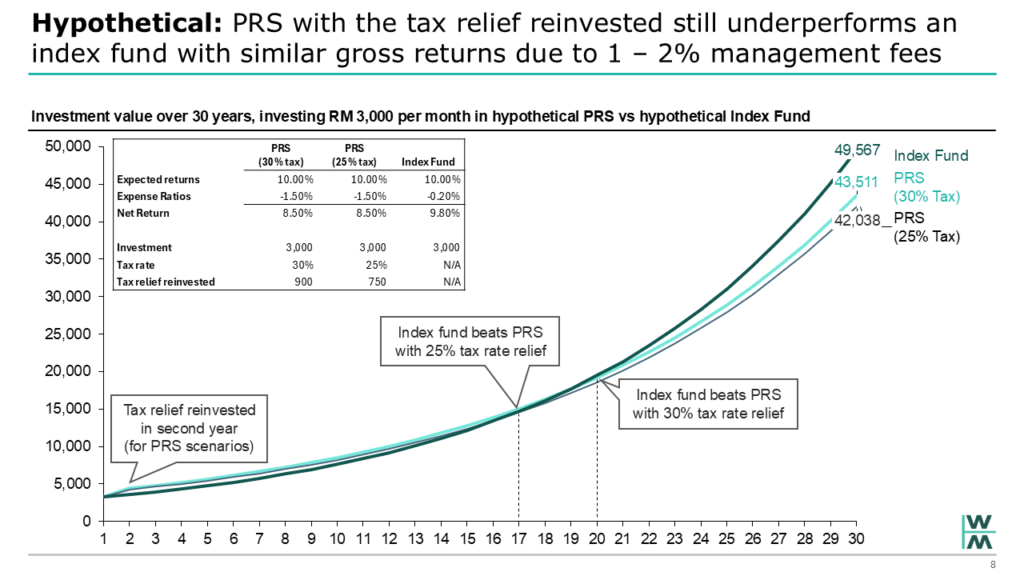
You might think that’s a long time for it to outperform. But it does. And compounding on your gains works for many, many more years until your retirement and beyond.
Let’s use actual past performance figures, shall we? (Yes I know, past performance does not equal future returns).
Let’s use the best-performing PRS that is listed on FSMOne. Too bad the data only shows 10-year performance. I would have loved to find the 20-year performance (notice how no active fund manager ever displays their 20 or 30-year fund performances?)
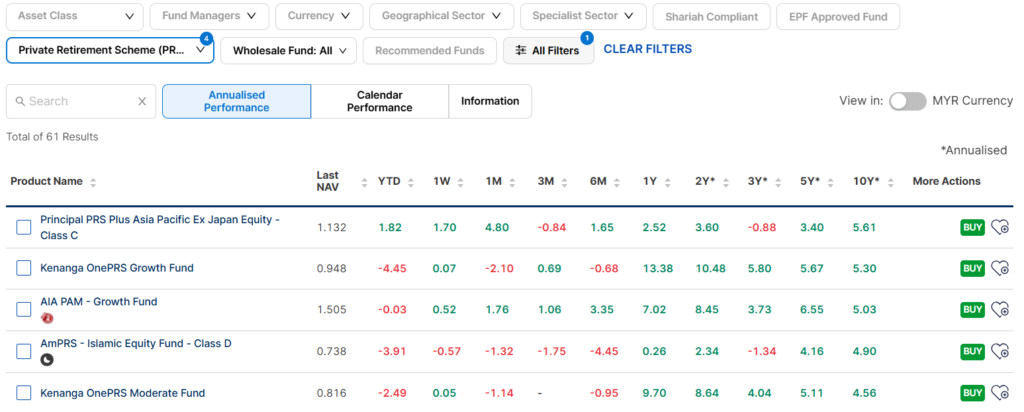
So let’s use the Principal PRS Plus APAC Ex Japan Equity PRS fund. I’ll be generous and bump up the returns to 6.4% instead of 5.61%, because I’m nice. Also because the S&P 500 has been doing really well recently (13.3% in the past 10 years!)
When does the S&P 500 outperform both tax relief scenarios?
Almost immediately. And the potential difference after 30 years is staggering.
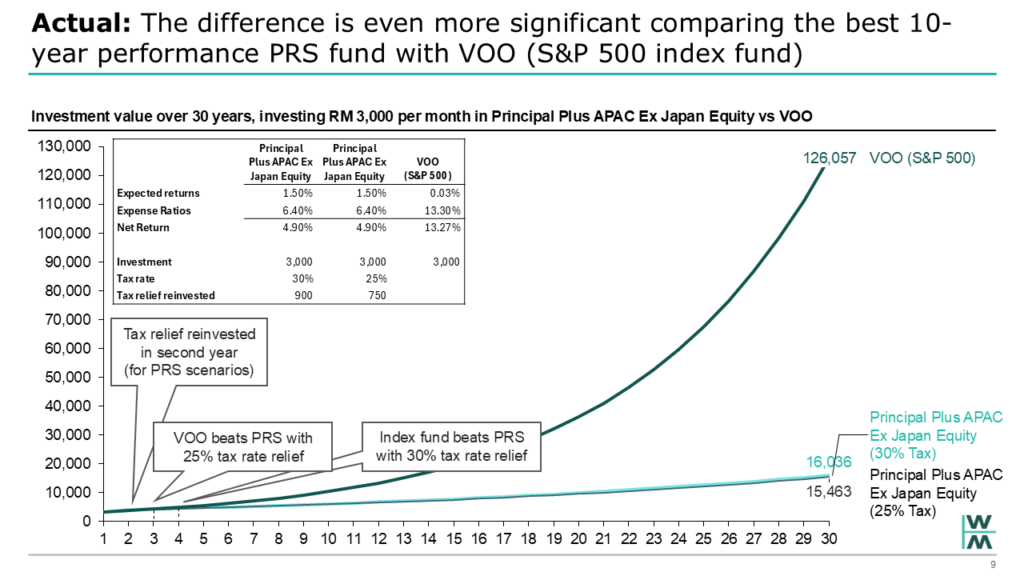
When compared to index funds which return ~10% p.a. returns, there is no chance I would advocate for anyone to invest in PRS with money locked up until retirement in subpar investments.
Note: For parents, investing RM 8,000 in SSPN for tax relief is interesting even though the returns are even less than PRS. It’s an interesting option as you can withdraw the funds at any time. I am using it as an asset to park a portion of my emergency funds and benefit from the tax relief. The difference between SSPN vs a money market fund (or similar vehicles for an emergency fund) is relatively minute.
The underlying lesson here is to evaluate options using longer-term time horizons when compound interest is involved. It’s long-term gain over short-term gain.
In the spirit of investing for the long-term…
7. Opportunity costs of spending vs. investing can be much higher than you think.
Think about the opportunity cost, especially before splurging on non-critical expenses. That RM 5,000 new phone will cost you RM 40k net worth after 20 years. Feel like buying that 20k watch? That would have been 160k after 20 years. Which is more important to you?
Once you start thinking about how much you can grow your wealth instead of spending that money, you might think twice.
By the way, as a simplistic calculation, you can 8X any value to calculate the effect of compounding after 20 years. This is based on the rule of 72 with 10% returns, which means doubling every 7 years. Hence over 20 years, the value will double three times, which is 2 X 2 X 2 = 8X
Now how about if you pay for that splurge using debt?
8. Consumption using debt means what you pay is much more than you realise.
That RM 200k car loan over 9 years costs you RM 250k. That 50k holiday on your credit card cost 75k if you took 2 years to pay it off.
I’m not even including the opportunity costs you incur where that additional money could be invested for additional wealth creation.
And finally, to shatter some conventional myths…
9. Renting property gets you further ahead financially vs buying property, and with more flexibility.
I’ve already written about this as the answer for question 4, but it bears repeating, to break through psychological biases.
There is no shame in renting, even for long periods of time. Don’t let societal, cultural or peer pressure force you into decisions you aren’t ready to make.
But if you do buy a property for other non-financial reasons, ideally try to rent first, then buy subsale instead of off-the-plan.
Closing thoughts
I fully agree with Albert Einstein that compound interest is the eighth wonder of the world. Even extremely small increments and returns, when compounded can yield spectacular results.
Understanding compound interest helps shed light on the saying “poor stay poor whilst the rich get richer”. The so-called rich have more wriggle room to invest and allow compound interest to work its magic, whilst the not-so-fortunate have less savings to invest and take on more debt, resulting in a negative compound interest spiral.
No other phenomenon or tool is as critical to the foundation of building wealth. Regardless of being rich or not-so-rich, fortunately, the positive effects of compound interest are available to everyone. What matters is how much we understand and leverage mastery of the concept to play the game.



